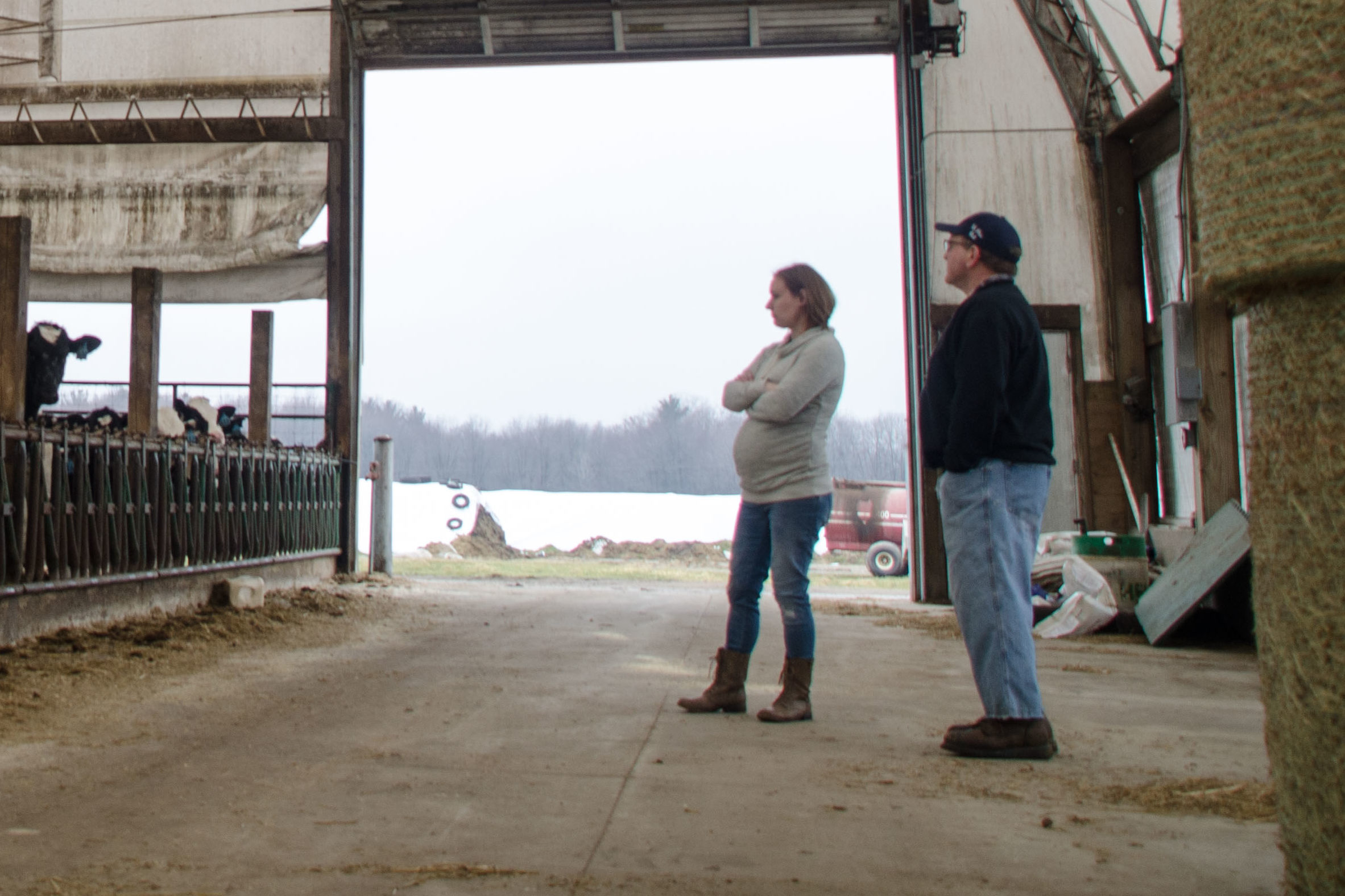It’s three o’clock in the morning. The sun has not yet risen, and 500 acres of Coopersville, Michigan cropland waiting to cultivate forages for voracious dairy cattle are concealed by the dark of night. Inside, florescent lights illuminate the milking parlor, the stage set to begin a twice-daily routine.
The sort gate opens and with it, the first group of cows are ushered into the parlor. Their hoofs clatter on the concrete as they line up to be milked, five on each side of the parallel set up.
Down below in the milkers pit, Alan Koppenol and his team begin working with each cow. Their booted feet shuffle across blue and white checkered mats. Their gloved hands meticulously clean the udders, prep and strip the teats, and apply the milking machine. Soon enough, milk pulsates through the network of hoses and pipes.
For dairy farmers, it’s a familiar scene. Yet this parlor, these farmers and the 195 cows on Koppenol Dairy Farm bring in something exceptional: the highest quality milk in MMPA. At the 101st Annual State Delegate Meeting on March 23, Koppenol Dairy Farm was announced the MMPA Top Quality Award winner.
With a somatic cell count (SCC) of 49,750 cells per milliliter, pre-incubated bacteria count of 1,250 cells per milliliter and raw bacteria count of 1,000 cells per milliliter, the Coopersville farm beat out all 1,167 MMPA members to achieve the highest quality milk in fiscal year 2016.
Lower somatic cell and bacteria counts indicate better animal health and higher milk quality. MMPA members begin receiving premium payments and are eligible for quality awards for milk averaging less than 250,000 SCC.
The competition is stiff. Five hundred and twelve quality awards were earned by MMPA members in 2016, 38 of which were gold awards for members maintaining an SCC average of less than 100,000. Yet Koppenol Dairy Farm, like the cream in their milk, rose to the top.
The Koppenols’ milk averages 3.82 percent butterfat and 3.22 percent protein, plus production averages of 85 pounds of milk produced per cow per day.
The farm’s quality figures today are the result of a steady decrease in counts, though producing high quality milk is not a new endeavor. Last year, Koppenol Dairy Farm produced the second-highest quality milk in the co-op. Five years ago, their SCC was an impressive 70,500. Ten years ago, it was a respectable 106,667.
As on most farms producing high quality milk, consistency is key. “We start the same time every day. And we remember to stick to the details,” says Alan Koppenol, owner of Koppenol Dairy Farm. Koppenol works alongside his wife, Deborah, partner, Ken Raterink, secretary and daughter, Robin Liszewski, and six employees.

In the milk parlor, that consistency dictates the milking procedure. First, they clean off the udder and teats with a cloth rag and pre-dip with a sanitizing pre-milking solution. Then they dry the teats with a cloth before applying the milking unit which milks the cow until it pops off the teats with automatic take offs. Finally, they post dip with Derma-Sept to condition and protect the teat ends.
According to Koppenol, their quality breakthrough is hard to define. “There are a lot of things we’ve done, but the improvements didn’t always show immediately after each step. Some shifts were in changing inflations once a month and switching to using individual towels. It was a lot of little things,” he admitted.
Inflations—the soft inner liner of the milking unit—are changed every 30 days by a specialist who comes to inspect the milking system to ensure it is working properly.
The Koppenols monitor SCC when stripping the milk by examining the sample for chunks or abnormal milk. “Years of experience” back their decision making and in knowing how to address any problems.
They are diligent in treating dry cows with a 60-day dry period and monitor their fresh cows throughout the calving process and when they return to the herd. In cases of mastitis—they usually see two per month—the farm addresses the problem immediately and cull if there is no improvement.
Koppenol took over from his parents in the 1980s. Then, they milked 45 cows in a stanchion barn. The herd has increased since that time to 195 milking cows. Sixteen years ago, they built a freestall barn and then the current parlor a year later.
The stalls in the barn feature a mat of crushed rubber. Every night, they sweep each stall and apply 4 pounds of lime and top with sawdust. While the sawdust increases cow comfort, it also allows environmental bacteria to grow so the lime works to counteract the growth. Lime bedding contributes to lower somatic cell counts.
Allowing the cows time to spend relaxing in these stalls is a priority. “We keep our cows comfortable by giving them time to lay and keep the milking time down to the shortest possible,” Koppenol adds.
The farm grows hay, corn, soybeans and wheat on 500 acres to feed their cattle. One of the drivers of their high-quality milk according to Koppenol is in providing consistent, high quality feed year-round.
“When we had the cows in a pasture and during the winter, their feed intake was inconsistent. Now things are more consistent whether its June or January and this has improved our quality,” he said.
However, Koppenol advises fellow farmers the most important way to achieve high quality milk is by stressing prevention. He says it’s harder to treat high counts and mastitis than it is to prevent an issue from starting.
When three o’clock in the afternoon rolls around, the second milking of the day will begin on Koppenol Dairy Farm. Though their diligent routine in the parlor brings forth quality milk, the way they farm and the way they care for the animals all contribute to their achievements. Soon milk will fill up the bulk tank, awaiting the next step in the supply chain, where high quality milk is prized.
Koppenol Dairy Farm’s Five Tricks to Attaining High Quality Milk
- Prevention first: It’s better to prevent mastitis than to have to work harder on treatment.
- Keep it clean: Cleanliness can be hard to achieve on a dairy farm, but it’s key to keeping your counts low.
- It’s who you know: Work with a network of knowledgeable people to rely on and ask questions to.
- Stay modern: Modern technology has changed how cows are housed and milked to encourage quality milk production.
- Consistent feeding: Ensure high quality feed is provided to the cows all year round.
–Allison Stuby Miller
This article was originally published in the April 2016 issue of the Michigan Milk Messenger.

